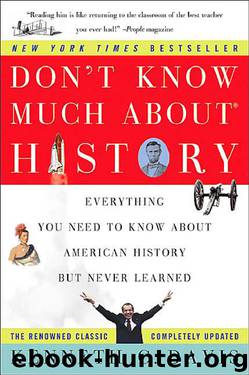DON'T KNOW MUCH ABOUT HISTORY: EVERYTHING YOU NEED TO KNOW ABOUT AMERICAN HISTORY BUT NEVER LEARNED (Don't Know Much About...(Paperback)) by Kenneth C. Davis

Author:Kenneth C. Davis [Davis, Kenneth C.]
Language: eng
Format: epub
Tags: Reference, Questions & Answers, General, United States, Questions and answers, History
ISBN: 9780060083823
Publisher: Perennial
Published: 2004-04-01T04:00:00+00:00
338
D O N ’ T K N O W M U C H A B O U T H I S T O R Y
neers introduced the moving assembly line, an idea proposed in a 1911
book by Frederick W. Taylor, the mass-produced Model T revolutionized the auto industry. The efficiency of the assembly line cut the price tag on the Model T from $950 in 1908 to under $300. By 1914, Ford Motors turned out 248,000 Model Ts, almost half of all autos produced, at the rate of one every 24 seconds. Realizing enormous profits, Ford made headlines by paying his workers $5 per day, almost double the going rate. Ford himself was clearing up to $25,000 per day. Paying his workers more money was Ford’s only way to keep them from quitting the monotonous, dehumanizing assembly line. He also realized that it was one way to enable his workers to buy Fords.
For Americans, it was love at first sight with the automobile. It is fair to say the Model T revolutionized American life. When Congress enacted highway fund legislation in 1916 and the country embarked on a massive road-building era, the American dream of freedom on the open road became a new reality. In a short time the auto industry became the keystone of the American economy, in good times and bad.
New industries in roadside services—such as service stations, diners, and motels—sprang to life all over the country. The country cottage was no longer the exclusive preserve of the Vanderbilts and Morgans. The auto gave the working and middle classes a sense of accomplishment. The new, auto-induced sense of freedom, and the economic prosperity created by the automobile and related industries, helped to open up American society in the 1920s.
Henry Ford cared little for social improvements or the broad sweep of history. “History is more or less bunk,” he said. Autocratic and conservative, he tyrannized his workers. He fired anyone caught driving a competitor’s model. Gangster tactics were used to maintain discipline in plants, and unionizing efforts were met with strike-breaking goon squads. Unions were kept out of Ford plants until 1941. Ford’s attitude was that workers were unreliable and shiftless. In the midst of the Depression, he blamed the workingman’s laziness for the nation’s economic problems. “The average worker,” said Ford, “won’t do a day’s work unless he is caught and can’t get out of it.”
His conservatism spilled over into his political beliefs. An isolationist in foreign policy—although his plants won big defense jobs during both world wars—Ford was also an outspoken anti-Semite. Ford bought a Boom to Bust to Big Boom
339
newspaper, the Independent, that became an anti-Jewish mouthpiece.
The paper was involved in the American publication of The Protocols of the Elders of Zion, an anti-Semitic propaganda tract that had first appeared in Russia in 1905 to castigate Jews. But Ford’s conservative, stubborn streak cost him in the long run. Unwilling to adapt to changing styles, Ford Motors later slipped behind more aggressive competitors like General Motors. Yet
Download
This site does not store any files on its server. We only index and link to content provided by other sites. Please contact the content providers to delete copyright contents if any and email us, we'll remove relevant links or contents immediately.
| Archaeology | Essays |
| Historical Geography | Historical Maps |
| Historiography | Reference |
| Study & Teaching |
Underground: A Human History of the Worlds Beneath Our Feet by Will Hunt(12024)
Sapiens by Yuval Noah Harari(5294)
Navigation and Map Reading by K Andrew(5111)
The Sympathizer by Viet Thanh Nguyen(4305)
Barron's AP Biology by Goldberg M.S. Deborah T(4099)
5 Steps to a 5 AP U.S. History, 2010-2011 Edition (5 Steps to a 5 on the Advanced Placement Examinations Series) by Armstrong Stephen(3689)
Three Women by Lisa Taddeo(3354)
Water by Ian Miller(3128)
The Comedians: Drunks, Thieves, Scoundrels, and the History of American Comedy by Nesteroff Kliph(3039)
Drugs Unlimited by Mike Power(2545)
A Short History of Drunkenness by Forsyth Mark(2233)
DarkMarket by Misha Glenny(2159)
The House of Government by Slezkine Yuri(2159)
And the Band Played On by Randy Shilts(2129)
The Library Book by Susan Orlean(2042)
Revived (Cat Patrick) by Cat Patrick(1963)
The Woman Who Smashed Codes by Jason Fagone(1929)
Birth by Tina Cassidy(1864)
The Absolutely True Diary of a Part-Time Indian by Sherman Alexie(1859)
